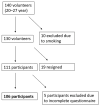Acceptance of Muffins (Sweet and Savory) with the Addition of T. molitor, A. diaperinus, A. domesticus, R. differens, Considering Psychological Factors (Food Neophobia Scale, Consumer Attitude)
- PMID: 38890963
- PMCID: PMC11171916
- DOI: 10.3390/foods13111735
Acceptance of Muffins (Sweet and Savory) with the Addition of T. molitor, A. diaperinus, A. domesticus, R. differens, Considering Psychological Factors (Food Neophobia Scale, Consumer Attitude)
Abstract
The aim of the study was to analyze the acceptance of muffins containing a 15% addition of powder from four edible insect species (Alphitobius diaperinus, Tenebrio molitor, Acheta domesticus, Ruspolia differens) in both savory and sweet versions, focusing on the psychological factors influencing their consumption. The study involved 106 adult consumers. Initially, the level of food neophobia (FNS) among participants was determined. Over 80% displayed low to medium levels of neophobia. Similar results were obtained when assessing attitudes towards insects, with most participants showing positive and ambivalent attitudes. Based on these findings, the acceptance of insect-based muffins was evaluated. The level of acceptance of insects varied and depended mainly on taste, smell, and texture. Participants with lower levels of neophobia and positive attitudes towards consuming insects generally rated the insect muffins higher compared to those with higher levels of neophobia and negative attitudes. The sweet versions of insect powder muffins were rated higher, which also indicates preferences and dietary habits. Products with grasshopper powder (GS, GCL) were rated the lowest for both taste versions. Conversely, products based on buffalo worms (BS, BCL) were seen as having the greatest potential for acceptance. Understanding consumer attitudes, neophobia, and levels of acceptance provides valuable insights for designing new insect-based foods.
Keywords: acceptability; buffalo worm; consumer attitudes; edible insects; food neophobia scale; grasshopper; house cricket; mealworm.
Conflict of interest statement
The authors declare no conflicts of interest.
Figures





References
-
- Mariutti L.R.B., Rebelo K.S., Bisconsin-Junior A., de Morais J.S., Magnani M., Maldonade I.R., Madeira N.R., Tiengo A., Maróstica M.R., Cazarin C.B.B. The Use of Alternative Food Sources to Improve Health and Guarantee Access and Food Intake. Food Res. Int. 2021;149:110709. doi: 10.1016/J.FOODRES.2021.110709. - DOI - PubMed
-
- Phonthanukitithaworn C., Sae-eaw A., Tang H., Chatsakulpanya P., Wang W., Ketkaew C. Marketing Strategies and Acceptance of Edible Insects Among Thai and Chinese Young Adult Consumers. J. Int. Food Agribus. Mark. 2023;35:154–182. doi: 10.1080/08974438.2021.1979160. - DOI
-
- Andreoli V., Bagliani M., Corsi A., Frontuto V. Drivers of Protein Consumption: A Cross-Country Analysis. Sustainability. 2021;13:7399. doi: 10.3390/su13137399. - DOI
LinkOut - more resources
Full Text Sources

